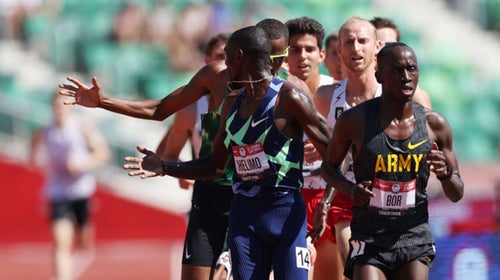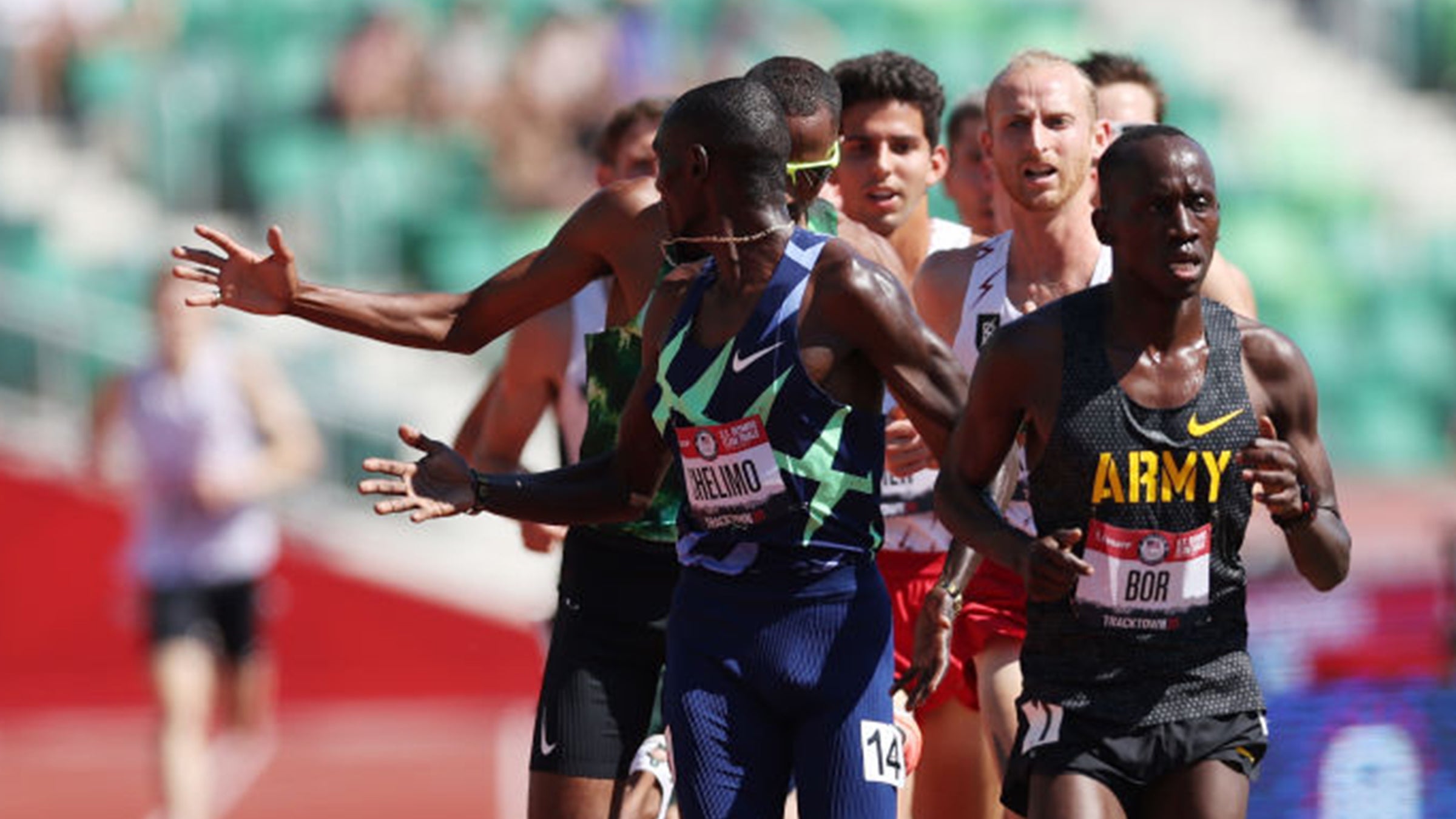In the 5,000-meter final of this year’s Olympic Trials, Paul Chelimo caught attention — and controversy — by clinching victory on the final straight by steadily “drifting” from lane 1 to lane 4. In the process, he forced those trying to overtake him to run wider, and wider, and wider, until eventually they ran out of room and he crossed the finish first.
It’s the type of thing that can cause the Internet to explode in chatter and leave road runners scratching their heads. Was that legal? Was it sporting? Are there any rules about this? And why are track rules so complex?
Road racing also has rules, but they are fairly simple. Line up as directed. Don’t start until told, don’t cut the course, and basically behave in a civilized manner. Do those four, and there’s not really a lot most of us can do wrong.
But in track meets, the rules are so complicated that the 2021 USATF rulebook is a staggering 267 pages. And while a lot of this is hyper-technical, such as when during a sprint race wind speed should be measured to determine if race times are wind-aided or record-legal, some are directly related to how you run the race.
Let’s start with the most obvious.
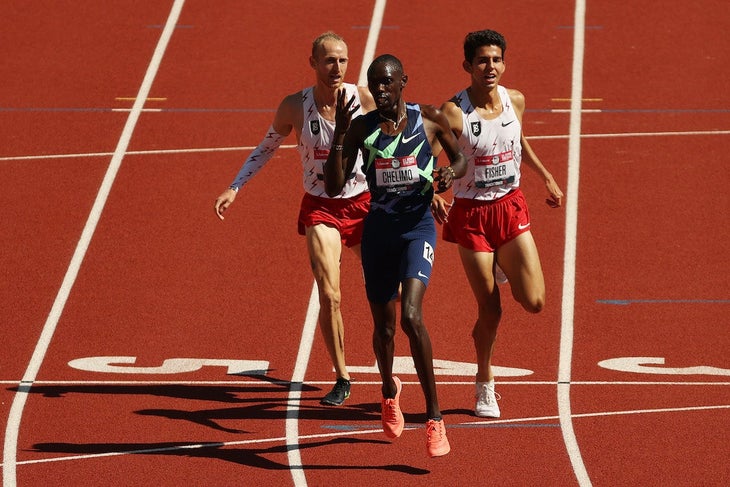
What’s the Issue with Chelimo’s “Drift”?
On its face, what Chelimo did was a rule violation. “[E]ach competitor,” the rulebook says, “shall run in a direct line after entering the final straightaway…unless there is another competitor in his or her path.” In other words, you can change lanes to pass someone, but not to prevent someone from passing you.
But violating a rule and being disqualified for it aren’t the same thing. Unless a “material advantage has been gained” or another runner has been jostled or obstructed, the rulebook goes on to say, “a competitor shall not be disqualified.”
I.e., no harm, no foul.
Why the leniency? Tom Heinonen, head coach of women’s cross-country and track coach at the University of Oregon from 1977 to 2003, suggests it’s partly a concession to human nature. When someone tries to pass you, he says, your nerves seem to be hardwired to veer toward them, in an effort to make them work harder to beat you. “It just happens,” he says, “inexorably and unknowingly.”
More importantly, nobody seems to have been truly impeded by Chelimo’s drift. Even the people he beat shrugged it off. “Grant Fisher and Woody Kincaid [the second and third place finishers] had no qualms,” Heinonen says.
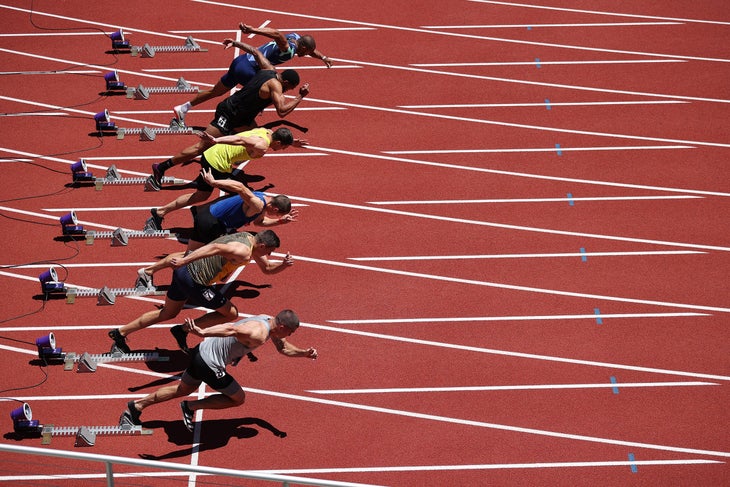
What About All Those False Starts?
The official rule on false starts is draconian. One goof and you are out. Its enforcement is more complex.
In distance races, false starts are rare. The main error runners can make is to step on the line when called forward to take their marks. If that happens, the starters just make them step back and do it over. No official wants to call a false start in a distance race, because there’s just not enough advantage to make a difference. Nobody steps on the line in a deliberate attempt to gain an edge.
Nor do distance runners have to “set” and hold motionless before the gun, the way sprinters must. Instead, movement is tolerated, so long as both feet remain in contact with the ground prior to the gun. Even then, the rules have an exception for “accidental overbalancing.”
Sprints are different. Because they can be won or lost by hundredths or even thousandths of a second, there is a real temptation to anticipate the gun.
The fastest anyone can react, researchers from the University of Michigan found in an analysis of 100m, 200m, 400m, and hurdle runners at the 2008 Beijing Olympics, is 0.109 seconds for men and 0.121 seconds for women. That’s the best possible; most of these Olympians were about 50 percent slower.
To alert officials to possible false starts, major meets use blocks with pressure sensors that can detect an attempt to push off too soon. If they detect such motion, the blocks send a tone to the headphones of the recall starter, who responds by pulling the trigger on the recall gun.
According to the rulebook, the blocks should only send this signal if a runner starts to push off within 0.10 seconds after the gun — slightly faster than the fastest reaction time the University of Michigan study found to be humanly possible.
In old-style races, this was all done visually. In fact, that’s still the case in lower-level races.
I’ve worked as a recall starter in such races. Every nerve in your body is wired for detecting false movement. The new technology simply magnifies that. The recall starter gets a tone from the blocks and, bang, pulls the trigger, because you can’t let everyone get 30 meters down the track before you make up your mind. If it was an equipment failure or you aren’t sure what caused it, you show a green card to the field. Nobody’s fault, try again.
In Eugene, however, there were heats in which it took up to six attempts to get a clean start.
“I understand it had to do with the degree of sensitivity of the blocks,” says Scott Phoenix, certification chair for track and field officials in Oregon. That problem, he adds, might have been caused by the blocks’ reaction to the intense heat.
Heinonen thinks the fault might not have lain in the blocks’ electronics, but the fact that the sky-high temperatures and intense sun made it impossible for the runners to stay still. According to one report, its surface temperature exceeded 150°F — nearly hot enough to cook a well-done hamburger. Sydney McLaughlin, winner of the women’s 400m hurdles, reported that after her semi-final heat, her knees were bleeding from having to kneel on the hot surface multiple times, due to multiple restarts.
McLaughlin was able to endure the pain and hold still for the start. But, Heinonen says, other singed runners may not have had the pain tolerance and may have flinched, triggering the blocks to send out false-start alerts.
What About Pile-Ups in the 800m?
The 800m is an odd race. It starts in lanes, but at the end of the first turn hits a “break line” (marked by tiny cones) at which runners can “break” for the inside in an effort to get an advantage on the next turn.
The rule is simple. “Your feet must be in contact with the track [i.e. in your lane] until after the break line,” says Phoenix.
That said, DQing a runner who tries to break a step too soon is tough. “That’s a very difficult thing to determine,” Phoenix says. “It has to be pretty obvious to call [it].”
More important is not to break too dramatically and veer too quickly toward the rail. “You can’t do any unpredictable, sudden movements that would cause people [behind you] to break stride,” Phoenix says.
Nor can you jockey for position so aggressively you step on the heels of the runner ahead of you. Athing Mu, who won the women’s 800m in the second-fastest time in American history, nearly went down shortly after the break line, Heinonen notes, when something like that happened to her in the finals. “Mu was hit from behind and sort of staggered,” he says. “That was scary.”
If she had gone down and lost the race, the rules wouldn’t have been much help.
If you are tripped in a qualifying heat, you can be reinstated in the next round (even if the person who tripped you isn’t disqualified for it). But if you are tripped in a final, it’s over (unless you can pick yourself up fast enough to somehow get back into the hunt for a medal — very difficult in a race as short as the 800m). Except for a fall that occurs within the first 10 meters. If that happens, the starters can recall the race and start it over.
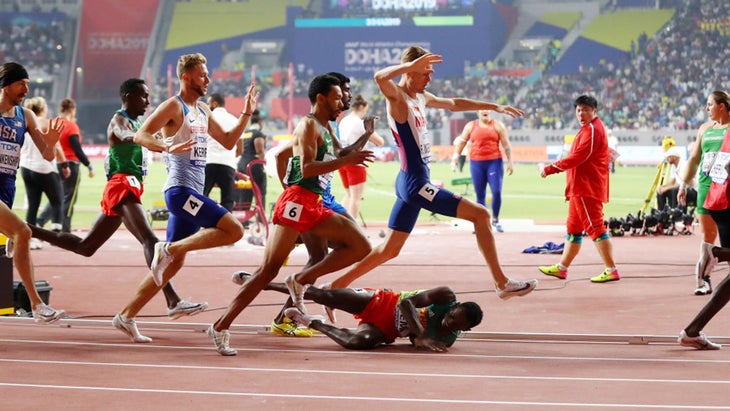
What Are the Rules for Longer Races?
In races ranging from the 1500m to the 10,000m (or the 800m, after the break), the most important rule is that you can’t change lanes — inward or outward — if in the process you “jostle,” “run across,” or “obstruct” another runner “so as to impede his or her progress.”
This is often interpreted as requiring you to be separated from the nearest runner by one stride. But nobody really knows how to measure a stride, especially in the heat of a race. Some runners have long strides; others have short, quicker ones. Not to mention that your stride length at an easy jog is a lot different from at a flat-out sprint.
“It’s an arbitrary thing,” Phoenix says.
In a nod to the Tour de France, he adds, “It’s like bicycling. You’ve got people who are just inches away from each other and have to hold their lines.”
It’s amazing that cyclists can do this as well as they do, with so few crashes, he says, adding: “It’s equally remarkable that people are able to run in distance races, tightly packed, with as few problems as they have.”
What officials look for, he says, are occasions when a runner suddenly throws up his or her hands and alters stride. “[That] almost exclusively happens when they have to break stride,” he says. “That indicates that somebody has cut across in violation of the rule.”
The same basic rule also applies to following too closely. But in championship meets it’s got to be pretty flagrant before someone calls it — a lot more flagrant, for example, than occurred in the 5,000m, when Chelimo repeatedly looked over his shoulder and chastised runners behind him for being too close. In tight packs, it really is a lot like being in the peloton of a bike race.
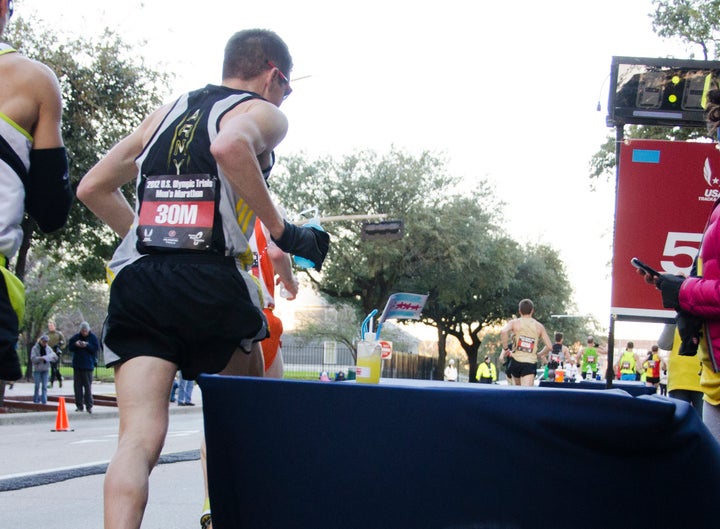
What About Marathons?
The marathon is a road race, and most of its rules are simple and familiar to anyone who’s ever run on the roads. But at the elite level, there are a few peculiarities.
The biggest have to do with aid stations. Prior to the race, runners are expected to fill their own fluid bottles, mark them for where they want them, and provide them to race officials, who will then set them out at the right aid stations. At the aid stations, runners have to collect their own bottles off the tables, without assistance.
Throughout the course, they cannot take assistance from spectators, coaches, or anyone else. But Phoenix says, it is legal to share water bottles with other runners, something that often occurs as a show of good sportsmanship when a competitor fumbles a water-bottle pickup, or otherwise misses an aid station.
Repeatedly doing this for the same friend or teammate, however, might not be the wisest idea. “Continuous support might be considered [illegal] assistance,” Phoenix says.
The rules about not cutting off other runners also apply. But, Heinonen notes, this seems to be a lot less of an issue in the marathon than on the track.
In marathons, there is often a blue line painted all the way along the course, showing the shortest way to run the tangents (without cutting a corner on grass or a sidewalk — which is illegal and technically can get you disqualified). But, Heinonen says, it doesn’t seem to matter as much as the lane markings on a track. “If you watch any major marathon, they don’t seem to be paying any attention,” he says.
Other Rules
There are, of course, hundreds of other rules. If you step off the track, for example, even on a straightaway, you are deemed to have dropped out of the race and cannot return, even if you have gained no advantage. Except if you are pushed off. Then you can return, so long as you do so expeditiously.
Though, there’s an exception to that rule, too, for track races 20,000 meters or longer, or any road race (including the marathon). Then, you can leave the course so long as, in returning to it you don’t take a shortcut. We saw this a few years ago in the Boston Marathon, for example, when Shalane Flannagan hit a port-a-potty for a quick pit stop. Sometimes, even the pros have to answer the call of nature.
If you want your own copy of the rulebook, you can download it from USATF. Have fun figuring it out.
